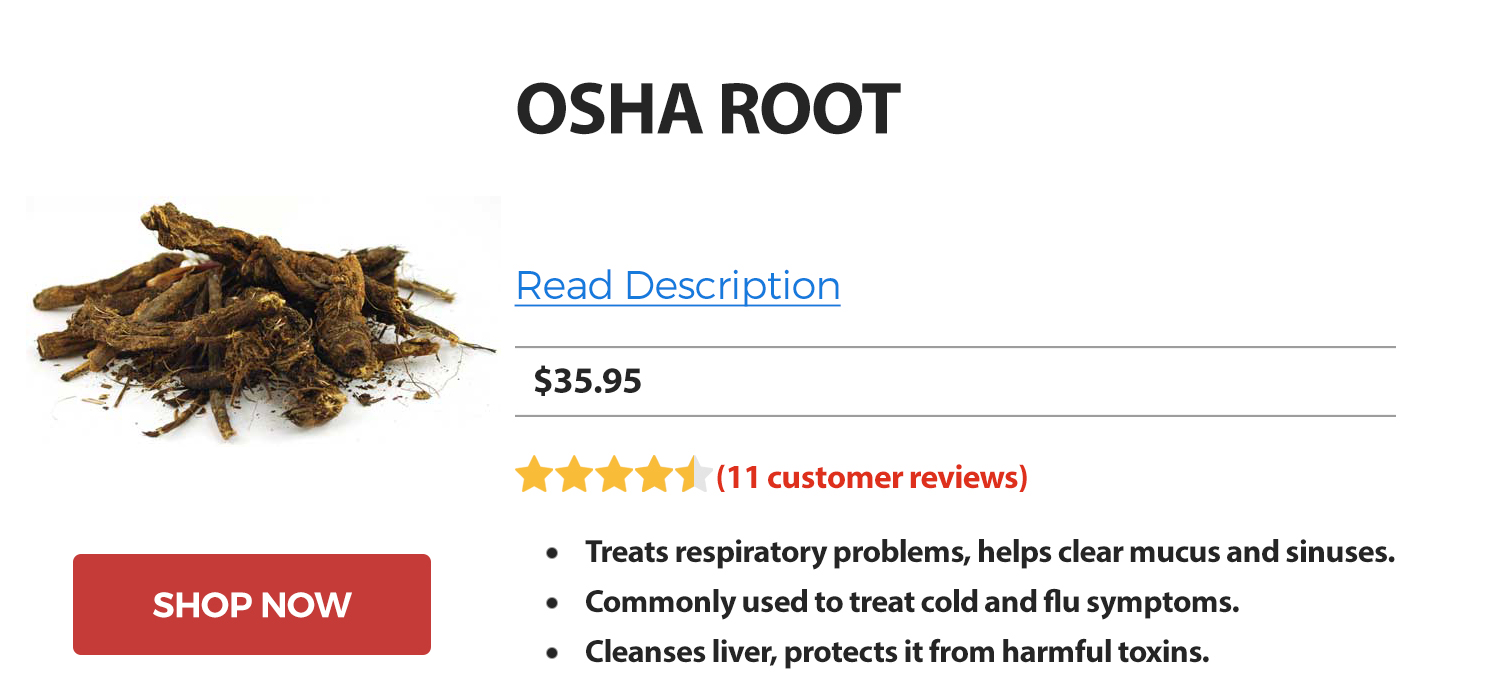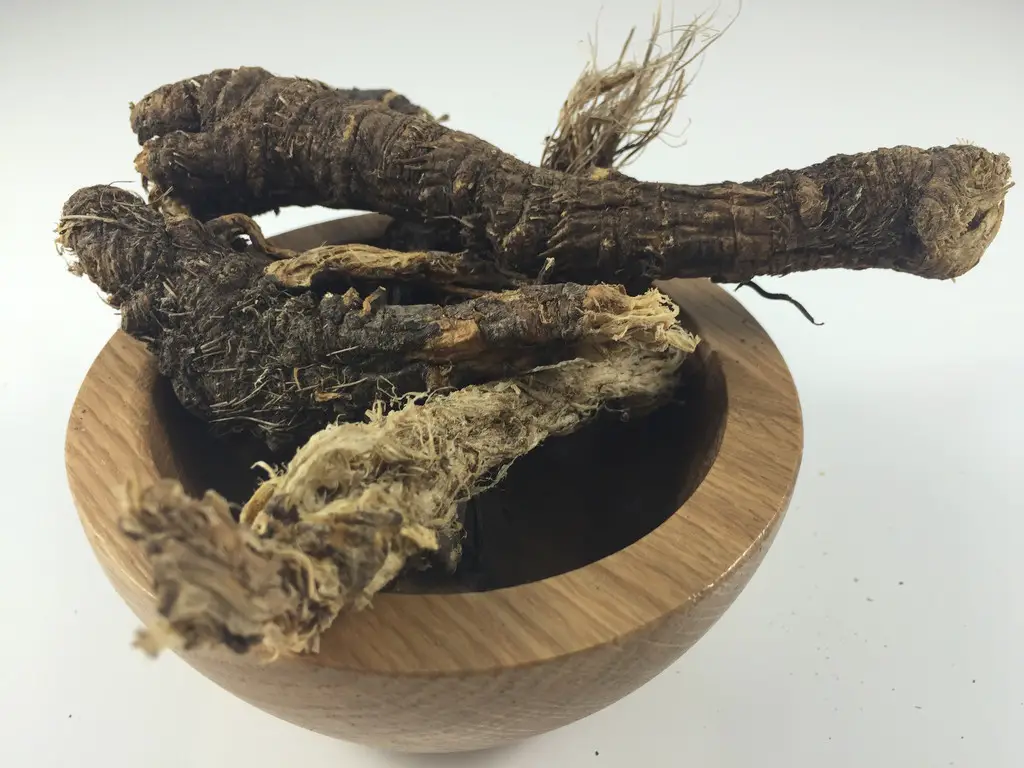What is Osha Root?
Osha root, sometimes referred to as Porter’s licorice-root, bear root, or chuchupate, is scientifically known as Lingusticum porteri and belongs to the family Apiaceae which includes celery, carrots and parsley. It is a perennial plant, native to the western mountains of the United States and Mexico. The plant is characterized by clusters of white flowers that may have a red blush and oblong branched leaves. Because the seeds of the plant are not normally transported by wind or animals, plants are usually found growing in circular clusters. It is also grows very slowly and can take up to ten years to reach a suitable mass for harvesting. It is important to properly identify Osha when harvesting because of its physical similarities to poison hemlock (Conium maculatum). One major difference between the two plants is the smell of the roots; hemlock having an acrid smell and Osha having a spicy smell.
Historically, indigenous peoples have used the root of the plant to treat a number of illnesses including fever, respiratory issues, digestive ailments, wounds, and muscle aches. Today, a number species of Ligusticum have been used in medicine in the Americas, Asia and Europe. The root has a strong taste that is often compared to a mixture of licorice and celery. Since Osha is valued medicinally, as a flavour additive and it is not typically domestically-cultivated, the overall plant population has faced some depletion due to overharvesting. However, cultivation and conservation efforts have mostly restored supplies of the root.
Osha Root Benefits and Uses
Colds, flus, and coughs
Because of its aromatic nature, Osha root can be used to clear congestion. Osha root can be dried and burned to create a fragrant smoke that can be inhaled to clear chest or sinus congestion. Alternatively, the root can be brewed as a tea, which can also soothe sore throats. Since it is unknown what compounds are produced when burning the root, (some plants may form potentially carcinogenic compounds when burned) tea is the preferred method of delivery. Chewing the raw root will also clear congestion and soothe sore throats quickly; however the flavor may be overwhelming for some.
Diarrhea, vomiting, and indigestion
Osha can calm the stomach and treat a number of gastric disorders. The root can be taken as a tea or it can be eaten or chewed raw. The root can be eaten or spit out after chewing. It has been reported to be used to treat colic. It will also relieve vomiting and diarrhea as well as some more mild symptoms such as gas.
Wounds, bruises, and muscle aches
Osha root has an antibacterial and antimicrobial effect when applied topically. Powdered root can be applied directly to wounds to inhibit infection or the root can be ground into a poultice. A poultice or liniment can also be applied to bruises or aching joints for mild pain relief. A bath can also be prepared to soak sore joints and relieve skin irritation. Although many compounds in Osha root have yet to be identified, a few have been shown to produce mild analgesic, or painkilling effects, making Osha a great additive to bandages or joint wraps. When applied directly to the skin, the root will also produce a gentle warming effect.
Osha Root Side Effects and Dosage Information
Osha root will cause some mild sweating, which is the source of its reputation as a detoxifying agent. However, scientific evidence suggests that detoxification cannot occur through sweat. When it comes to taking the right dose of Osha, there are very few guidelines. This is because the plant has not been extensively studied. Additionally, unlike other herbs, very few active therapeutic compounds have been identified for Osha. Women that are pregnant or breastfeeding should avoid taking Osha, but for others, Osha seems to be extremely well-tolerated much like the other roots in the Apiaceae family. It has also been reported to be safe for use in children. However, it is recommended to follow all dosing instructions provided by the manufacturer for commercially available Osha tinctures and powders. Overall, Osha is a very safe medicinal herb with a long documented history of use. If handling whole roots, wash hands after cutting or handling the root, since it can be irritating to the eyes.
Did you know? Osha Root is great for congestion? It’s called the “Mountains Lung Cleanser” for a reason! Get it => https://t.co/fus9PwiwR6
— MedicinalHerbals (@MedicinalHerbal) February 27, 2017
How to make Osha Root Tea
To make Osha Tea, it is recommended to take either fresh or dried root and cut it to around the size of a normal tea bag. From there, the root can be broken up or mashed and immersed in hot water. If a stronger tea is desired, the root can be boiled. If bought as a powder, the herb can simply be added to hot or cold water.
Where to Buy Osha Root?

Osha can be expensive when compared to other herbs because of its limited availability due to conservation efforts and because it is not widely commercially cultivated. A 2013 report, showed that the average price for a pound of whole Osha root was around $40. The majority of Osha products are still wildcrafted, and it is important to select a manufacturer that practices sustainable harvesting methods. Osha can be bought as whole roots, extracts, powders, tinctures, and capsules. However, traditional medicine only uses the roots in whole root and powdered forms. Roots may be dried or fresh and should be harvested when the plant goes dormant in the fall or in the early spring before the plant forms flower buds.
Final Thoughts on Osha Root
Overall, Osha is a great natural alternative to typical flu and allergy medications and indigestion aids like Pepto-Bismol. The root has a long history of use with no reported negative effects, other than its overwhelming flavor, eye irritation from direct contact, and the sweating that it induces. Traditionally, the herb is made into a tea, chewed on, applied to joints as a poultice or liniment, applied to wounds as a powder, or burned and inhaled; however, companies now produce capsules, extracts, and tinctures – although the efficacy of these products are unknown. Although, often more expensive and possibly more difficult to procure, purchasing Osha as whole roots offers the best versatility in use. As with all herbal supplements, it is important to consult with a health professional if you are taking any medications before using Osha, but overall the herb is well tolerated and consistently used in traditional medicine to this day.
References:
http://plants.usda.gov/core/profile?symbol=LIPO
http://nativeplants.ku.edu/wp-content/uploads/2013/12/Osha-Report-2013.pdf
http://muse.jhu.edu/article/270193
http://www.pollinator.org/Resources/Osha%20-%20Ligusticum.draft.pdf






I have been growing Osha root plants for 22 years I would consider helping someone else grow it by cloning my plants or selling a few seeds
Hi Viki, I am interested in growing Osha root plants.
I would love to learn and help! My phone is +17342864612
Vicki – I’m interested. Can you contact me re: cloned plants I can grow roots?